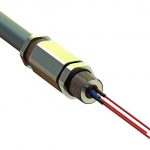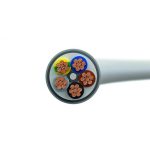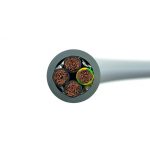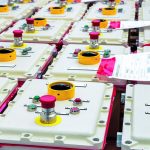The correct selection of cable glands is very important for the integrity of the explosion protection. The glands have to match the cables that are used as well as the type of protection employed for the equipment at the place of installation. Direct entry into flameproof Ex d enclosures via Ex d cable glands is still a popular installation method, but the correct selection and installation of armoured or possibly barrier cable glands can challenge the user.
Cable glands are the most common means of leading cables into hazardous area equipment. There are several aspects to be considered when selecting the right cable glands for a specific application. Basically, three main types of cable gland exist:
- Cable glands made of plastic or metal for use with non-armoured cables
- Cable glands made of metal for use with shielded cables
- Cable glands made of metal for use with armoured cables
Several important criteria need to be considered when selecting glands for armoured cables, for example the type of armour, the inside and outside diameter and the thread and spanner size. The gaskets at the enclosure play a crucial role with regard to the IP protection. A distinction must be made here between glands which are screwed into threaded holes, where the IP protection is guaranteed by a normal O-ring, and installation in through-holes with lock nuts. In the latter case, a flat gasket is required to compensate for the through-hole tolerances.
Hazardous area protection method
The above-mentioned cable gland types can be designed for either the “flameproof, Ex d” or “increased safety, Ex e” type of protection or for a combination of the two. Ex d certified cable glands are usually triple certified, including Ex e and Ex t “protection by enclosure” for use in hazardous dust areas. Cable glands designed for Ex e applications also have Ex t certification and are hence suitable for both gas and dust applications. All Ex d cable glands require a thread engagement of at least five full turns in order to ensure proper functioning of the flameproof gap between the male and female threads.
Although with hazardous area certification there is no official need for cable glands to be used with intrinsically safe circuits, the state of the art is to choose Ex e certified glands for such applications.
Barrier cable glands
Barrier cable glands are Ex d glands for armoured or non-armoured cables which are filled with a sealing compound around the individual cable conductors, the aim being to maintain the safety of the flameproof equipment in which they are fitted. If installed correctly the compound prevents a possible internal gas explosion from exiting through the cable gland. It is mandatory to use barrier glands if the internal design and the externally installed cable length cannot guarantee the safety of the equipment in conjunction with standard cable glands. The specific installation standard IEC 60079-14 (Explosive atmospheres – Part 14: Electrical installations design, selection and erection) explains in paragraph 10.6.2. that the use of normal Ex d certified cable glands is only allowed when both of the following conditions are met:
- The connected cable is at least 3 m in length.
- Cables shall be sheathed with thermoplastic, thermosetting or elastomeric material. They shall be circular and compact. Any bedding or sheath shall be extruded. Fillers, if any, shall be non-hygroscopic.
Otherwise, barrier glands have to be used. The most critical point when verifying whether barrier glands can be avoided concerns the design and quality of the cable. This gives rise to questions such as “When is a cable not ‘circular’ anymore?”, “What does ‘compact’ mean in reality?” or “How can the user tell wether a bedding or sheath was extruded or a filler is non-hygroscopic?”.
The cable manufacturer is unlikely to give official confirmation of compliance with one or all of the above conditions. Furthermore, cable gland manufacturers cannot usually provide information on cables which are proven in use with ordinary, non-barrier cable glands, even though some combinations may have been tested in realistic laboratory explosion experiments. It is a well-known fact among the hazardous area equipment installer community that the use of barrier glands or of ordinary Ex d glands for armoured cables is a source of numerous potential assembly errors. Even perfectly executed explosion protection can depend on an elastomeric seal no more than 10 mm in length.
Environmental conditions
Cable glands need to protect the equipment against environmental influences which could intrude via the cable entries. The typical minimum ingress protection nowadays is IP 66 or IP 68. In the past, rubber shrouds were used as an option to protect metal glands against moisture and corrosion. However, such shrouds are not recommended anymore because modern metal cable glands are already highly corrosion-resistant. The collection of water and moisture between the shroud and the gland, so that an unwanted biotope develops, represents a bigger headache. Hazardous area cable glands usually have a wide ambient temperature range. Plastic glands are generally suitable for -40 to +60 °C whereas metal glands are rated for -60 to +80 °C. Special cable glands for temperatures up to +200 °C or more, as well as for very low temperatures are also available in the market.
Installation considerations
Correct installation is the key to a safe application. Murphy’s law also applies here: anything that can go wrong, will go wrong. The simpler the gland design, the fewer the mistakes that can be made on site. Ex d cable glands for armoured cables comprised of up to 10 different parts are a good example: they have to be combined in exactly the right sequence and manner. Correct cutting of the armour, precise positioning at the end of the armour cone and proper fixing of the armour with the correct tightening ring are crucial. One simple but common problem is the loss of internal components when disassembling the armoured glands prior to installation. The armour cone and the tightening ring are especially vulnerable here. Quality glands lock the two parts together with inner O-rings. The avoidance of water ingress is an additional advantage. Applying the correct tightening torques at each step of the installation procedure is paramount, although in practice many installers tend to rely on their experience rather than on a torque spanner.
Cable glands are among the most crucial components for ensuring safe installation of electrical equipment in hazardous areas. Although everybody knows how they work in principle, a whole series of mistakes can potentially be made during the selection and installation process which can harm or even destroy the integrity of the explosion protection.
Hall 9, Booth D76
www.cpp-net.com search: cpp0217pepperl
Rainer Nägle
Product Group Manager Electrical Explosion Protection Equipment,
Pepperl+Fuchs
Share:










